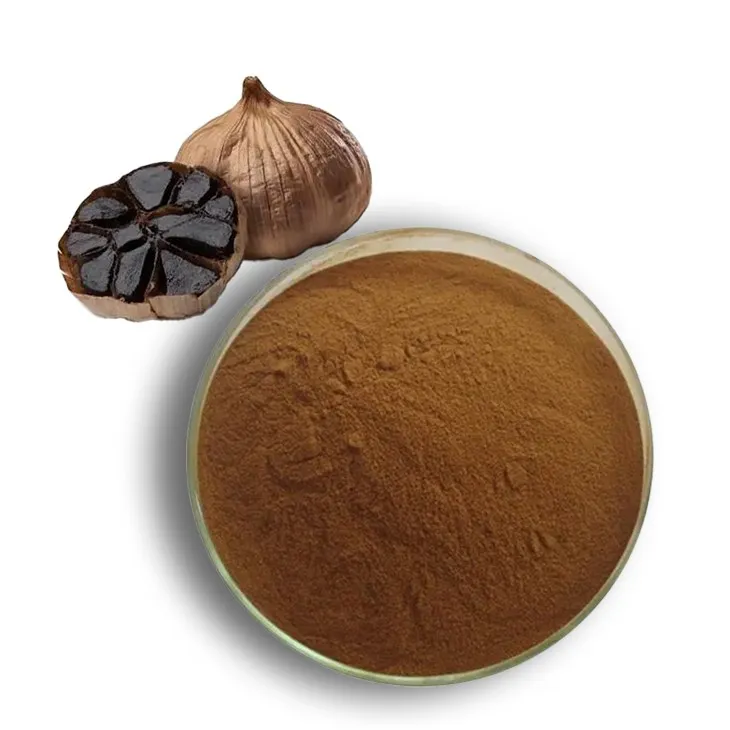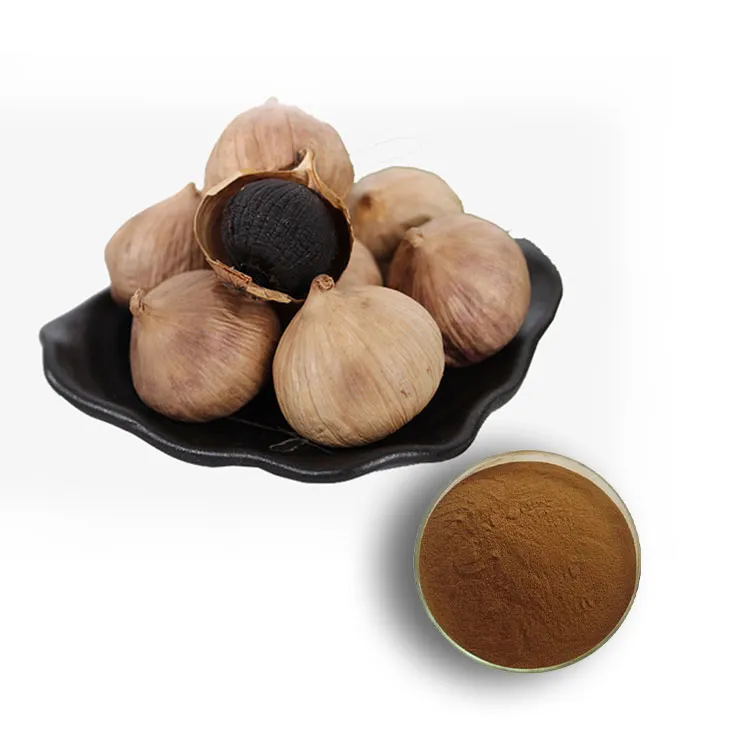- 0086-571-85302990
- sales@greenskybio.com
The process of extracting sulfur - containing compounds from black garlic in black garlic extract.
2024-11-26

1. Introduction
Black garlic, a product obtained through the fermentation of fresh garlic, has gained significant popularity in recent years due to its enhanced nutritional properties and unique flavor. One of the key aspects of black garlic is its rich content of sulfur - containing compounds. These compounds play important roles in various biological activities, such as antioxidant, anti - inflammatory, and antimicrobial functions. Extracting sulfur - containing compounds from Black Garlic Extract is a complex process that requires careful consideration of several factors, including raw material selection, extraction methods, and purification processes.

2. Raw Material Selection
The quality of black garlic is crucial in the extraction process. Firstly, the source of fresh garlic used to produce black garlic matters. Garlic varieties with high sulfur content in their original state are more likely to result in black garlic rich in sulfur - containing compounds. For example, some local or heirloom garlic varieties may have a higher sulfur potential.
The fermentation process of black garlic also affects the content and nature of sulfur - containing compounds. Optimal fermentation conditions, such as temperature, humidity, and fermentation time, need to be carefully controlled. Longer fermentation times may lead to the formation of more complex sulfur - containing compounds. However, if the fermentation is too long, it may also cause the degradation of some beneficial compounds. Generally, a fermentation time of around 30 - 60 days under controlled temperature and humidity conditions is considered appropriate for maximizing the sulfur - containing compound content in black garlic.

3. Extraction Methods
3.1 Solvent Extraction
Solvent selection: Different solvents can be used for the extraction of sulfur - containing compounds from Black Garlic Extract. Organic solvents such as ethanol are commonly used. Ethanol has several advantages. It is relatively safe, has a good solubility for many sulfur - containing compounds, and can be easily removed during the subsequent purification process. Other solvents like methanol or acetone may also be considered depending on the specific requirements of the extraction.
Extraction procedure: The black garlic is typically ground into a fine powder to increase the surface area for extraction. The powder is then mixed with the selected solvent in a suitable ratio. For example, a ratio of 1:5 (black garlic powder: solvent) may be used. The mixture is stirred continuously for a certain period, usually several hours at room temperature or under mild heating conditions. Stirring helps to ensure that the sulfur - containing compounds are effectively dissolved in the solvent. After the extraction, the mixture is filtered to separate the solid residue from the solvent - containing the extracted sulfur - containing compounds.
3.2 Supercritical Fluid Extraction
Principle: Supercritical fluid extraction (SFE) is a more advanced extraction method. Supercritical carbon dioxide (sc - CO₂) is often used in this process. The principle of SFE is based on the fact that a substance in its supercritical state has unique properties, such as a high diffusivity and low viscosity, which make it an excellent solvent for extracting various compounds. In the case of black garlic, sc - CO₂ can selectively extract sulfur - containing compounds while minimizing the extraction of unwanted substances.
Procedure: The black garlic sample is placed in an extraction vessel. Supercritical carbon dioxide is pumped into the vessel at a specific pressure and temperature (usually around 7 - 30 MPa and 31 - 60 °C). The sc - CO₂ penetrates the black garlic matrix, dissolves the sulfur - containing compounds, and then the mixture of sc - CO₂ and the extracted compounds is transferred to a separation vessel. By reducing the pressure in the separation vessel, the carbon dioxide reverts to its gaseous state, leaving behind the extracted sulfur - containing compounds.
3.3 Microwave - Assisted Extraction
Mechanism: Microwave - assisted extraction (MAE) utilizes microwave energy to enhance the extraction process. Microwaves can interact with the polar molecules in black garlic, causing rapid heating and creating microscopic channels within the sample. This helps in the efficient release of sulfur - containing compounds into the extraction solvent.
Operation: The black garlic is placed in a microwave - compatible container along with the extraction solvent. The system is then irradiated with microwaves at a specific power and time. For example, a power of 300 - 600 W for 5 - 15 minutes may be used. After the microwave treatment, the mixture is cooled and filtered to obtain the extract containing the sulfur - containing compounds.

4. Purification Processes
4.1 Filtration
After the initial extraction, the extract often contains solid particles, such as remnants of the black garlic matrix. Filtration is the first step in the purification process. Simple filtration using filter papers can remove larger particles. However, for more efficient filtration, membrane filters with different pore sizes can be used. For example, a 0.45 - μm membrane filter can be used to further purify the extract, removing smaller particles and some impurities.
4.2 Centrifugation
Centrifugation can be used to separate substances based on their density differences. In the case of Black Garlic Extract, centrifugation can help to remove any remaining undissolved particles or substances that may have a different density from the sulfur - containing compounds in the extract. The extract is placed in a centrifuge tube and spun at a specific speed (e.g., 3000 - 5000 rpm) for a certain period (e.g., 10 - 15 minutes). After centrifugation, the supernatant containing the sulfur - containing compounds can be carefully separated from the pellet at the bottom of the tube.
4.3 Chromatographic Purification
Column Chromatography: Column chromatography is a widely used method for purifying sulfur - containing compounds from black garlic extract. A column is filled with a stationary phase, such as silica gel or an ion - exchange resin. The extract is loaded onto the top of the column, and a mobile phase (a solvent or a solvent mixture) is then passed through the column. Different sulfur - containing compounds will interact differently with the stationary and mobile phases, resulting in their separation as they move through the column. For example, if silica gel is used as the stationary phase and a mixture of ethanol and water as the mobile phase, different sulfur - containing compounds will elute at different times depending on their polarity and other chemical properties.
High - Performance Liquid Chromatography (HPLC): HPLC is a more advanced chromatographic technique. It offers higher resolution and can be used for the precise separation and purification of individual sulfur - containing compounds. In HPLC, the extract is injected into a high - pressure system where it is passed through a column filled with a very fine stationary phase. The mobile phase is pumped at a high pressure, and the separation is monitored by a detector. This allows for the identification and collection of specific sulfur - containing compounds with high purity.
5. Conclusion
The extraction of sulfur - containing compounds from black garlic extract is a multi - step process that involves careful selection of raw materials, appropriate extraction methods, and efficient purification processes. Each step plays a crucial role in obtaining high - quality sulfur - containing compounds. The choice of extraction method depends on various factors, including cost, efficiency, and the specific requirements of the end - product. Purification processes are necessary to remove impurities and obtain pure sulfur - containing compounds for further applications in the fields of medicine, food, and cosmetics. Future research may focus on optimizing these processes further, exploring new extraction and purification techniques, and investigating the biological activities of the isolated sulfur - containing compounds in more detail.
FAQ:
What are the main sulfur - containing compounds in black garlic?
Black garlic contains various sulfur - containing compounds, such as allicin and S - allylcysteine. Allicin is known for its potential antibacterial and antioxidant properties. S - allylcysteine is considered to have health - promoting effects including antioxidant and anti - inflammatory activities.
How is the raw material of black garlic selected for the extraction?
When selecting black garlic for extraction, factors like the quality of the original garlic, the fermentation process it has undergone, and its maturity are considered. High - quality raw garlic with proper fermentation resulting in well - formed black garlic is preferred. The garlic should be free from mold, pests, and other contaminants. Also, the size and uniformity of the black garlic cloves can play a role in ensuring consistent extraction results.
What are the common extraction methods for sulfur - containing compounds from black garlic extract?
Common extraction methods include solvent extraction. Organic solvents such as ethanol are often used. Another method could be supercritical fluid extraction which uses supercritical carbon dioxide. Solvent extraction with ethanol is relatively simple and cost - effective. Supercritical fluid extraction can provide a purer extract with better selectivity, but it requires more specialized equipment.
How is the purification process carried out?
The purification process may involve techniques like chromatography. For example, column chromatography can be used to separate different sulfur - containing compounds based on their different affinities to the stationary and mobile phases. Filtration is also a part of the purification process to remove any insoluble impurities. Additionally, crystallization can be used to obtain pure sulfur - containing compounds in a solid form.
Why are sulfur - containing compounds in black garlic important?
Sulfur - containing compounds in black garlic are important because they are associated with various health benefits. They have antioxidant properties which can help in reducing oxidative stress in the body. Some of these compounds may also have anti - inflammatory effects, which can be beneficial for conditions related to inflammation. Moreover, they may contribute to the overall flavor and aroma of black garlic, which is also important for its use in the food and nutraceutical industries.
Related literature
- Extraction and Characterization of Bioactive Compounds from Black Garlic"
- "Sulfur - containing Compounds in Fermented Black Garlic: Properties and Potential Health Benefits"
- "Optimization of the Extraction Process of Sulfur - containing Compounds from Black Garlic"
- ▶ Hesperidin
- ▶ Citrus Bioflavonoids
- ▶ Plant Extract
- ▶ lycopene
- ▶ Diosmin
- ▶ Grape seed extract
- ▶ Sea buckthorn Juice Powder
- ▶ Fruit Juice Powder
- ▶ Hops Extract
- ▶ Artichoke Extract
- ▶ Mushroom extract
- ▶ Astaxanthin
- ▶ Green Tea Extract
- ▶ Curcumin
- ▶ Horse Chestnut Extract
- ▶ Other Product
- ▶ Boswellia Serrata Extract
- ▶ Resveratrol
- ▶ Marigold Extract
- ▶ Grape Leaf Extract
- ▶ New Product
- ▶ Aminolevulinic acid
- ▶ Cranberry Extract
- ▶ Red Yeast Rice
- ▶ Red Wine Extract
-
Lemon Juice Powder
2024-11-26
-
Angelica sinensis extract
2024-11-26
-
Saffron Extract Powder
2024-11-26
-
Peppermint Extract Powder
2024-11-26
-
Polygonum multiflorum extract
2024-11-26
-
Black Rice Extract
2024-11-26
-
Horse Chestnut Extract
2024-11-26
-
Alfalfa Meal
2024-11-26
-
Cat Claw Extract
2024-11-26
-
Avocado Extract Powder
2024-11-26





















